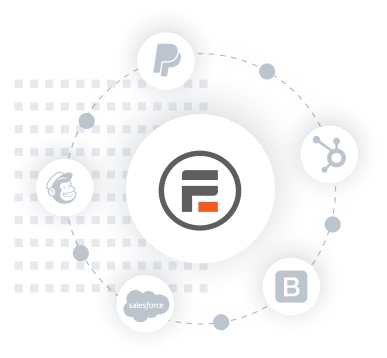Is your lead generation form optimized? Here are 9 stats that prove your online forms could use some fine-tuning. These lead generation examples will help you capture more leads!

When it comes to a lead generation form, there are a lot of variables. Believe it or not, the lead gen form isn't the only thing that matters!
In this post, we're going to shine a light on all the angles of lead generation forms that make a difference. We'll use some stats and lead generation examples too. The info here should help you generate more quality leads and improve the user experience on your sites.
The tips in this article are aimed primarily at WordPress users. However, even those using over types of websites can learn a lot here. If you want more potential customers from your web forms, read on!
1. Form Design
Let's get the obvious out of the way: form design matters when it comes to lead generation tactics. And one study by the landing page experts at Unbounce proves it very well.
They took an 11-field contact form and replaced it with a 4-field version. Guess what happened? Form submissions increased by 160%. What's more, they did not find any difference in lead quality between those who filled out the 11-field form and the 4-field form.
Fewer form fields is one thing, but here's another: a clear call to action. In some cases, the CTA can make all the difference. Your form and CTA should work together and reinforce each other. A CTA button with the words "get started" could be more exciting than "submit" for example.
If you want to design better lead forms, the tools you use can make all the difference.
Later on, we'll talk about one of the more important parts of form design: multi-step forms. If you want to improve your form design quickly, some solid form templates can really help!
2. Landing page design
Here's an interesting stat found by Omnisend in 2018. Landing pages, the least popular type of signup form, have the highest conversion rate at 23%. Popups, however, the most popular signup form, have the second-lowest conversion rate at 3%.
What does this mean? Should you scrap pop-ups and just create a ton of landing pages? Not exactly. But these stats do prove that landing pages with forms can capture a lot of leads.

The main difference between a landing page and a pop-up? Landing pages are designed to catch leads from qualified traffic sources. Pop-ups act like a catch-all to hopefully convert traffic that would otherwise be leaving your site. Not exactly a fair comparison because these are 2 different parts of the sales funnel.
Nevertheless, you'll want to improve landing page design to increase leads. So how do you do it?
There are several great tools that can help there. We recommend SeedProd - a drag and drop landing page builder loaded with lead generation form templates. These folks know how to economize form fields for conversions.
While not quite a free trial, their pro version does have a 14-day money back guarantee. Be sure to check them out!
3. Website page-load time
By now you should probably know how important page-load time is. Would you wait more than a few seconds for a page to load? Probably not!
We've written about ways to speed up WordPress already. But page speed is important no matter what platform you use to build your site. The stats have no problem reflecting this fact either.
Internet experts Portent say the first five seconds of page-load time have the highest impact on conversion rates. Website conversion rates drop by an average of 4.42% with each additional second of load time. Yikes!
There's really a lot you can do to improve load times on your site. But the easiest thing you can do is use an amazing tool like WP Rocket. They automate almost every aspect of how your website loads. This is especially helpful if you aren't a coder!

4. Engaged users convert into leads
What's a great way to boost your lead generation form? Make sure your target audience is on your site and engaged.
Calculators lead magnets are a great way to both engage and capture leads at the same time. This is pretty much the fastest possible way of capturing interested leads from website traffic.
As of 2021, there are 2.9 billion monthly active Facebook users. If you can engage these users on your site, then you can increase your chances of turning them into a lead. One easy example: Fitness tracking websites like Fitbit. Users can display their achievements via social media directly on site.
Have you set up a membership site or have users of any kind on your site? You can really boost engagement by allowing users to display social feeds in their profiles.
Smash Balloon is a great WordPress plugin for this. It allows you to display feeds from Twitter, Facebook, Instagram, and YouTube. Depending on your website, this could really help keep your audience engaged. And the more engaged they are, the more they will turn into leads.

5. Email marketing for improved lead quality
You might be wondering what email has to do with a lead generation form. Well, the email notifications from a lead generation form could make all the difference. The fact is the lead generation process doesn't stop when you've collected an email address.
Not convinced email is huge? According to Hubspot, email generates $38 for every $1 spent, which amounts to a 3,800% ROI. To state the obvious: that's huge!
If you aren't already doing this, make sure your lead generation forms are connected to your email platform of choice. If your form builder has email notifications built-in, even better.

6. Optimize forms for lead generation
Here's another great stat that Hubspot discovered in 2017. Organizations generate an average of 470,000 website visitors, 1,800 leads, and 300 new customers per month. Simply put, this means you need to get a lot of form submissions to generate leads.
But are there other ways to increase leads too? Sure! Optimize your forms for lead generation. There are a few key ways of doing this:
- Multi-page forms. How do you feel when you see a very long form? You never want your users to feel like they have to do work to submit a form. Dividing your form into smaller parts can help improve conversions a lot when your forms have many fields.
- Conditional forms (sometimes called smart forms). These use conditional logic to only show the form fields that matter most to each particular user.
- Don't require all fields. Some information you will always need, like email addresses. But other information can selectively be considered "nice to have" as opposed to "required".
- Make multiple forms. If you want users to sign up for your website, here's a good option. Make the signup form fast and ask them to fill out more information later. This is a common strategy used by business directory websites.
7. Cultivate leads with marketing automation
Salesforce said in 2017 that 67% of marketing leaders currently use a marketing automation platform. Are you among them? If you aren't that means your competition could be beating you.
What happens to a lead after they fill out a form on your site? If the answer is "nothing", you're in trouble!
Form builders with integrations to marketing automation platforms like Salesforce and Hubspot can do a lot of the hard work for you. If your forms aren't connected to your marketing, you could be missing out big time.
If you use a plugin like Formidable Forms though, you can connect Salesforce, Hubspot, Zapier, ActiveCampaign, and a whole bunch of other platforms too. Why let your leads just sit in some list somewhere?

8. Use analytics to find areas for improvement
Here's another stat from Hubspot that talks about what you should be doing. 15% of marketers measure the success of their content programs by how many leads they generate. Are you measuring these digital marketing statistics?
Turns out that measuring the success of your content marketing strategy is only the tip of the iceberg too. When it comes to lead generation, blog posts, and everything else on your site - you need data. Google Analytics is a great tool for this.
An even better tool? Give MonsterInsights a try if you use WordPress. The main issue with Google Analytics is how difficult it is to use. This plugin streamlines the most important data you need and puts it right in your WordPress dashboard.

9. Try converting leads with other lead generation tools
According to Wishpond, Contest CTA's have a 3.73% higher conversion rate when compared to other CTA's. Considering that a better prize will probably increase that conversion rate even higher? Those are great numbers.
There are a number of great giveaway and contest platforms available, but if you use WordPress, use this one: RafflePress. It lets you trade user actions for entries into a contest. The user actions could be to share a tweet, follow a Facebook or LinkedIn account, or join an email list.
After a user has joined your email list, they are much closer to becoming a paid lead. If cultivated correctly, a giveaway could act as a great lead generation form!
It's hard to believe, but barely touched on the features that make Formidable Forms the best form builder for WordPress. Check out our premium plans risk-free with a 14-day money-back guarantee. Or give our free plugin a try!
 The Ultimate Quiz Score Calculator for WordPress
The Ultimate Quiz Score Calculator for WordPress 11 Best WordPress Lead Generation Plugins To Capture Emails
11 Best WordPress Lead Generation Plugins To Capture Emails How to Make a Pay Per Lead Affiliate Program in WordPress
How to Make a Pay Per Lead Affiliate Program in WordPress
I'm kinda glad to see that pop-ups are becoming less and less effective... hopefully this will mean less clients will continue asking me to setup the darn things for them! (and instead opt for something less annoying to users)